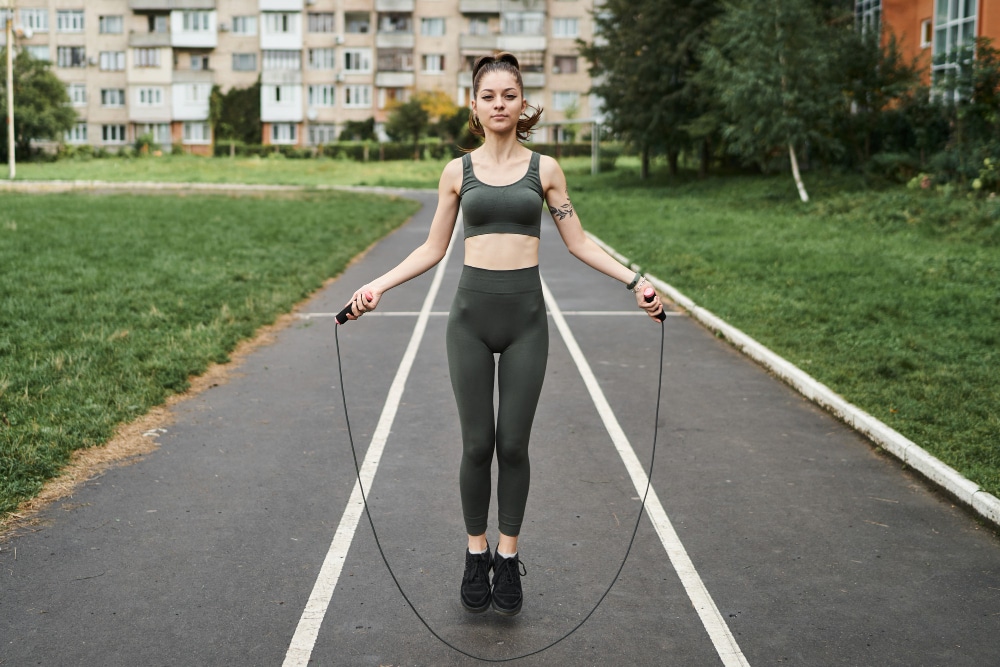The use of skipping rope in sports training has many advantages. Not only does it strengthen the whole body, it also has cardiovascular benefits. Why is skipping rope an effective way to strengthen your body? We tell you all about it.
A complete workout for the whole body
Jumping rope is not only child's play, it's also a complete exercise that calls on most of the body's muscles. In fact, skipping involves several muscle groups (hands, arms and legs).

Lower limb and abdominal strain
The leg muscles are, of course, the first to be affected by rope skipping. The quadriceps, hamstrings, calves and hip stabilizer muscles are constantly called upon when jumping, developing strength, endurance and stamina.
The abdominals play an essential role in maintaining spinal stability and overall balance. Constant work on them during jumps strengthens them, improving sheathing and overall posture.
Mobilization of upper limbs and back
Although not directly involved in the jump, the muscles of the upper body, i.e. the arms and shoulders, are also called upon throughout the exercise. Indeed, they are responsible for the movement of the rope and must coordinate their action to ensure proper rotation and a regular trajectory.
In addition, the back muscles, particularly those around the spine, also work in synergy with the abdominals and glutes to maintain a stable posture and correct lumbar lordosis.
The cardiovascular benefits of skipping rope
Jumping rope is also a cardio exercise that improves the cardiovascular system. It stimulates the heart and promotes good blood circulation throughout the body. Here are a few specific benefits:
- In addition to mobilizing a large number of muscles, skipping rope is also a powerful stimulant for the cardiovascular system. The efforts made by the whole body require large quantities of oxygen, causing the heart to beat faster and increase its output to supply the muscles with oxygen-rich blood.
- Regular practice of skipping rope thus helps improve heart and lung capacity, and thus contributes to the prevention of cardiovascular disease. It can also be beneficial for people with circulatory problems, as it stimulates venous return and peripheral blood circulation.
Heart rate adjustment
When jumping rope, heart rate accelerates rapidly, reflecting the intensity of the exercise. By adjusting the speed and duration of the workout, you can personalize your program to achieve different objectives: improving endurance, developing explosive strength (for example, by performing short but intense sets) or weight loss.
Promotes weight loss and muscle strengthening
Skipping is considered one of the best cardio exercises for burning calories and losing weight. If you're looking for a high-energy activity, a 30-minute skipping rope session can burn up to 500 calories. Of course, this figure varies according to the intensity of your session and your metabolism.
Setting up a customized program
To optimize your weight loss while strengthening your muscles, it's essential to put together a training program tailored to your level. After all:
- Too much practice can lead to injury;
- Conversely, sessions that aren't dynamic enough won't have the desired effect on your body.
Don't hesitate to seek professional advice to determine the length and pace of your sessions according to your goals and abilities.
Develops endurance and coordination
Skipping rope is also an excellent way to improve your endurance and coordination. In fact, this exercise requires good synchronization between arm, leg and trunk movements. Over the course of your sessions, you'll develop :
- Better muscular reactivity;
- Greater joint stability (ankles, knees, hips);
- Improvedoverall balance through stimulation of the proprioceptive system.
Variety of exercises to diversify benefits
There are many ways to have fun with a skipping rope, allowing you to diversify your exercises to avoid monotony and target different muscle groups:
- Basic jumps: simply jump to your feet while keeping your arms stretched out to the sides, turning the rope with your wrists.
- Alternating jumps: you jump by alternately lifting each leg, as if jogging on the spot, supported on the balls of your feet.
- Double jumps: for the more experienced, this variant involves passing the rope underfoot twice in a single jump, requiring greater coordination, speed and physical fitness.
- Cross jumps: to work the shoulders and core more, cross your arms in front of you while passing the rope over your head, then open your arms quickly to allow the rope to pass under your feet.
In addition to these different types of jumps, it is also possible to adjust the intensity and duration of sessions according to your objectives and level, for example by alternating periods of more intense work with moments of active recovery, in a HIIT (High Intensity Interval Training) type format.
Integration into various training programs
The skipping rope can also be integrated into different types oftraining, whatever the sporting level. For example:
- As a warm-up before a sports session to activate all muscles and prepare the body.
- As the main exercise in a muscle-strengthening or cardiovascular improvement program.
- Complement other sporting activities to vary and diversify training.
Benefits for other sports
If you're involved in other sporting activities, jump rope training can help improve them. For example:
- For combat sports, it helps build explosiveness and alertness;
- For runners, it strengthens leg muscles and helps reduce the risk of injury;
- For dancers and gymnasts, it promotes better body control.
Precautions before starting practice

Despite its many advantages, skipping rope can also put a strain on the joints, particularly the knees, ankles and back. So it's important to take a few precautions to avoid injury:
- Wear suitable shoes with good cushioning to reduce the impact on joints.
- Jump on a soft, non-slip surface that absorbs shocks (e.g. parquet rather than tiles).
- Start gradually, especially for people who are not accustomed to this practice or who have a history of injury.
- Don't hesitate to consult a doctor or sports professional before starting out, to ensure that skipping rope is well suited to your physical condition.
- Hold the handles of your rope firmly to prevent it from slipping during exercise;
- Pay close attention to the length of your rope and adjust it if necessary so that you can jump with ease;
- Be sure to keep your back straight and your abs tucked in during jumps, as this will help to engage the postural muscles;
- And don't forget to vary your jumps and rhythms to stimulate your muscles even more (one-footed jumps, feet together, etc.). Simple, affordable and versatile, it's suitable for all levels and can be practiced indoors or out.
Skipping rope: in a nutshell
This makes skipping rope a particularly effective exercise for strengthening the body and improving overall fitness. Simple, affordable and versatile, it's suitable for all levels and can be practised both indoors and outdoors. So don't hesitate, take up skipping rope and feel the benefits!











